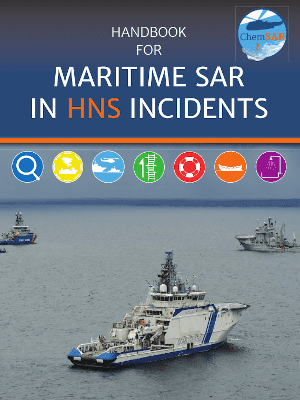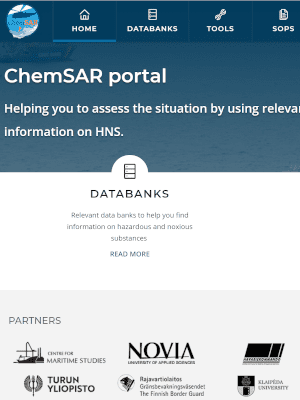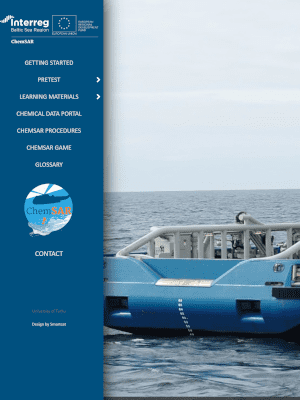ChemSAR
Lack of common procedures
There are about 2,000 commercial vessels operating in the Baltic Sea at any given minute and tens millions of tons of chemicals transported along. So far, there have been 100-200 incidents with commercial vessels reported annually. Due to an increasing amount of traffic in the Baltic Sea, traffic intersections and difficult waters, the probability of a largescale maritime incident remains high.
Incidents are transnational by nature
No country around the Baltic Sea has sufficient resources to tackle incidents involving hazardous and noxious substances (HNS) on its own, hence almost any maritime chemical incident is international by nature. However, there are no standardised procedures that national rescue authorities and rescue services could use in case of maritime HNS incidents to harmonise joint search and rescue (SAR) operations.
Budgets
in numbers
-
2.48MillionTotal
-
1.89MillionErdf
-
0.00MillionEni + Russia
-
0.00MillionNorway
Achievements
New procedures in place
The ChemSAR partners have jointly developed the first in the Baltic Sea region Standard Operational Procedures (SOP) for search and rescue (SAR) operations applicable to hazardous and noxious substances (HNS) incidents. The procedures were tested in table top exercises and simulations, and piloted in a live rescue exercise held on Estonian waters in September 2018 with over 100 role players, evaluators, and observers from eight countries. The procedures enable rescue maritime authorities and services to analyse capacities and capabilities, procedures and operational models in countries around the Baltic Sea, and to respond to HNS incidents in a more coordinated manner. The ready-made checklists additionally help harmonise e.g. assessing an incident, determining a restriction area, evaluating or decontaminating procedures.
Step by step in use
The ChemSAR operational plans and procedures are now compiled in a Handbook for Maritime SAR in HNS Incidents. The Finnish Border Guard, which coordinates rescue operations in Finland, uses the handbook in practice. The organisation also brought it up to the discussion at the HELCOM Response Working Group. The handbook is a guiding tool for rescue organisations in Sweden and Estonia too, including the Joint Response Coordination Centre Tallinn and Estonian Rescue Board. It is a reference document for rescue operations for the Lithuanian Armed Forces.
Towards standardisation
In most countries around the Baltic Sea, responsibility for dealing with HNS incidents is shared among several organisations. For this reason, it is a lengthy process until all organisations in all countries fully coordinate their operations. ChemSAR eLearning tool and chemical databank contribute to assimilating the guidelines into national procedures faster.
Further dissemination work of ChemSAR achievements is continued by the ResQU2 platform. The platform aims at improving preparedness of rescue authorities and services around the Baltic Sea to cope with incidents at sea and in ports, also those with hazardous and noxious substances.
ChemSAR matters
The Interreg project ChemSAR used EUR 1.89 million from the European Union to develop common operational plans and procedures for search and rescue operations in incidents involving hazardous and noxious substances. It offers ready-made tools for rescue authorities and services around the Baltic Sea to harmonise rescue operations, and in this way to save more lives and reduce the harm to the environment at the same time.
Now, the ChemSAR core partners contribute to the ResQU2 project platform that further develops the expertise of national authorities and rescue services to cope with accidents in the Baltic Sea and in ports, including those involving hazardous substances.
Outputs
Standard Operational Procedures (SOP) for Maritime Search and Rescue Operations Involving HNS Incide

ChemSAR Chemical Dataportal

ChemSAR eLearning Material

Project Stories
-
10.06.2021
Better prepared for emergencies thanks to Interreg
With an average of 300 accidents per year, as reported by the Baltic Marine Environment Protection Commission’s (HELCOM), the Baltic Sea seems to be a challenging area for navigation. The ResQU2 platform has reinforced the preparedness of rescue authorities, services, seaports and other authorities for large-scale incidents in the Baltic Sea.Read full story -
20.12.2016
ChemSAR presents safety operations at sea to commission Vice-President and commissioner
The Vice-President of the European Commission Jyrki Katainen and the Commissioner of Regional Policies Corina Creţu paid a field visit to one of Interreg Baltic Sea Region’s projects, ChemSAR, to observe transnational cooperation in safety operations at sea.Read full story
Partners
University of Turku
- TownTURKU
- RegionVarsinais-Suomi
- CountryFinland
- RepresentativeKirsi Laitio
- Phone
- E-Mail
- Web
Finnish Border Guard
- TownHelsinki
- RegionHelsinki-Uusimaa
- CountryFinland
- RepresentativePekka Parkkali
- Phone
- E-Mail
- Web
Novia University of Applied Sciences
- TownMain office: Vaasa Project: Turku
- RegionVarsinais-Suomi
- CountryFinland
- RepresentativeMirva Salokorpi
- Phone
- E-Mail
- Web
City of Helsinki
- TownHelsinki
- RegionHelsinki-Uusimaa
- CountryFinland
- RepresentativeVille Estlander
- Phone
- E-Mail
- Web
Estonian Police and Border Guard Board
- TownTallinn
- RegionPõhja-Eesti
- CountryEstonia
- RepresentativeDanel Tüür
- Phone
- E-Mail
- Web
Swedish Coast Guard
- TownKarlskrona
- RegionBlekinge län
- CountrySweden
- RepresentativeJohan Genestig
- Phone
- E-Mail
- Web
Klaipėda university
- TownKlaipėda
- RegionKlaipėdos apskritis
- CountryLithuania
- RepresentativeSergej Suzdalev
- Phone
- E-Mail
- Web
Free and Hanseatic City of Hamburg
- TownHamburg
- RegionHamburg
- CountryGermany
- RepresentativeKlaus Daginnus
- Phone
- E-Mail
- Web
Central Command for Maritime Emergencies Germany
- TownCuxhaven
- RegionCuxhaven
- CountryGermany
- RepresentativeSebastian Kroll
- Phone
- E-Mail
- Web
-
Project managerKirsi LaitioUniversity of Turku
-
Legal representativeTommi InkinenUniversity of Turku
-
Financial managerMirja JyrkinenUniversity of Turku
-
Communication managerMariikka WhitemanUniversity of Turku



